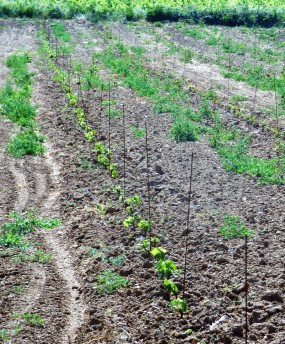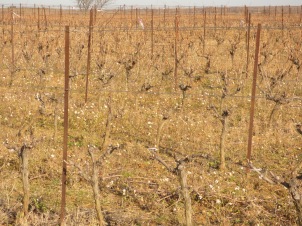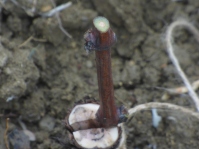Vendanges continued for the next couple of days, September 7th and 8th, but there was a literal dark cloud on the horizon in the form of a stormy forecast on the 9th. The predicted rainfall would do even more damage to this benighted vintage. Two varieties are especially vulnerable to rain, Aramon Noir and Cinsault. These varieties have big juicy berries and thin skins so with rain they swell and become dilute and prone to disease. Therefore, the team picked it by that evening.
The new plantation of Sainte Suzanne was revisited too, some of the bunches having been used for the PetNat a few days earlier. Clairette and Macabeu grapes were finished off, as the vines are young we left one bunch on each vine to help the vines mature.
Some lovely Grenache followed those white grapes to the cellar tanks, just next door in Sainte Suzanne itself. There is one more big parcel of Grenache to come from La Garrigue, it looks the best parcel of the year to my eyes. Then came the move to Segrairals to collect the Cinsault and Aramon. In recent years that vineyard has been transformed. Out went the Cabernet Sauvignon to be replaced by a myriad of varieties including the Aramon. Amongst the Noir was also Aramon Gris and some Aramon Rose, just to provide a little diversity and interest.
I have mentioned new plantations in Ste. Suzanne and Segrairals, there are others which will come on stream soon too. The Coutelou vineyards are being transformed year on year. This reflects Jeff’s philosophy and his passion for nature, different grapes and moving towards an era where varieties will have to respond to climate change which some of the imported grapes like Cabernet and Merlot might not do so well in the Languedoc. Aramon, of course, was widely planted in the region at the start of the 20thC, it was used to provide the light wine given to soldiers in World War 1. The Aramon picked here weighed in at a light 10% alcohol, the large berries providing much needed juice.
Another of the grapes from Segrairals was Mauzac, known more around Limoux and Gaillac, bright green in colour and very healthy. It looks an interesting addition to the Coutelou collection along with Grand Noir De La Calmette with its intense red juice from quite small berries. These small quantities will be blended together, Jeff will have a bigger colour palette with which to create his art. Blending is a skill, there have never been many single variety wines but it looks like there will be even fewer.
The forecast storm and rainfall proved to be lighter than expected though there was enough water to delay picking for a day. Cellar work is pressing ahead with the team carrying out the remontages etc. Fermentations have kicked off well, the small slates on each tank revealing the lowering of density in the juice as it turns to alcohol.
More bad weather is unfortunately predicted for next week, yet another problem to add to this year of non-stop problems. The pressure is on to use the next few days to harvest provided the grapes are right. The plot thickens.





















































































































